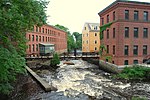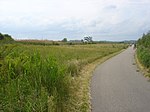Edward M. Kennedy Institute for the United States Senate
The Edward M. Kennedy Institute for the United States Senate (also known as the Kennedy Institute) is a non-profit civic engagement and educational institution on Columbia Point in the Dorchester neighborhood of Boston, Massachusetts, next to the John F. Kennedy Presidential Library and Museum on the University of Massachusetts Boston campus. Named for long-time U.S. Senator Ted Kennedy, the institute contains a full-scale reproduction of the United States Senate Chamber, a replica of Kennedy's Washington, D.C. office, and digital exhibits. The organization includes the Kennedy Home in Hyannis Port, which was donated to the institute in 2012 as part of a "mission of educating the public about the U.S. government, invigorating public discourse, emphasizing the importance of bipartisanship, and inspiring the next generation of citizens and leaders to engage in the public square." The Kennedy Institute is, along with the Bipartisan Policy Center and the Orrin G. Hatch Foundation, a co-sponsor of The Senate Project, whose goal is, through hosting a series of Oxford-style debates between leading U.S. Senators, to reintroduce the culture of seeking common ground and bipartisan consensus that has been the essence of the Senate since it was conceived in 1789.
Excerpt from the Wikipedia article Edward M. Kennedy Institute for the United States Senate (License: CC BY-SA 3.0, Authors).Edward M. Kennedy Institute for the United States Senate
William T. Morrissey Boulevard, Boston Dorchester
Geographical coordinates (GPS) Address Nearby Places Show on map
Geographical coordinates (GPS)
| Latitude | Longitude |
|---|---|
| N 42.315555555556 ° | E -71.035 ° |
Address
Edward M. Kennedy Institute for the United States Senate
William T. Morrissey Boulevard 210
02125 Boston, Dorchester
Massachusetts, United States
Open on Google Maps








